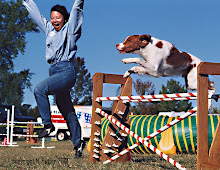[This was originally posted to the Fairmount Animal Hospital website on 15 December 2008.]
Dear Dr. Lee,
My Siberian Husky almost bit her veterinarian last week when we went in for a routine physical examination. He was trying to feel her abdomen, and she turned around an tried to nip him. I was terribly embarrassed, because while this is the first time she tried to bite, she has always been touchy about her belly, even as a puppy (in the past, she’s bared her teeth and growled). We eventually used a muzzle and the veterinarian was able to determine there was nothing obviously wrong with her. Other than getting her used to a muzzle, what can I do to help this situation?
Concerned in Cato
Dear Concerned,
I certainly appreciate your dedication to your dog’s well being. The physical examination is the foundation of good medical care for any pet, and in order for that to happen, the pet needs to be at least somewhat cooperative.
Desensitization to the veterinary exam should be done with all puppies and kittens, although there is no reason why you cannot do this with an adult dog as well.
Starting with her head, lift up her lips and inspect her teeth. Be sure to pull her lips back to look at her molars, too. Open her mouth and look at the roof of her mouth and her tongue. Peer into her ears, and massage them, and briefly insert a finger into the ear canal if it will fit. Massage her all over, including her face, neck, back, sides, underneath, upper limbs, lower limbs, tail and feet. Lift the tail, pick up a foot at a time, pinch the toenails. If she is sensitive in any of these areas, back off on the intensity of the touch, and reward her positively (verbal praise, small food treat), for allowing you to slowly increase the pressure and duration of touch in those sensitive areas.
If your dog flops over onto her back while you touch her, that is fine in the beginning, but consider that most of the veterinary exam is done with the dog in an upright position, and you may eventually want to train for that, as well.
Ask the veterinary office if it would be permissible to bring your dog in for a “happy visit” in which she walks into the hospital, walks on the scale, and interacts with some of the staff in a very positive manner. These “happy visits” involve no needles or other painful stimuli, and can teach your dog to be relaxed even in the waiting room.
Sincerely,
Dr. Lee
My primary objective is to help pets and owners enjoy a more satisfying relationship with each other and maintaining the pet’s health to maintain the pet’s quality of life. Pets have the ability to enrich our lives immensely, and I feel that owners also have a responsibility to enrich their pets’ lives, too.
Got a pet behavior question?
E-mail me at fah@fairmountanimal.com.
